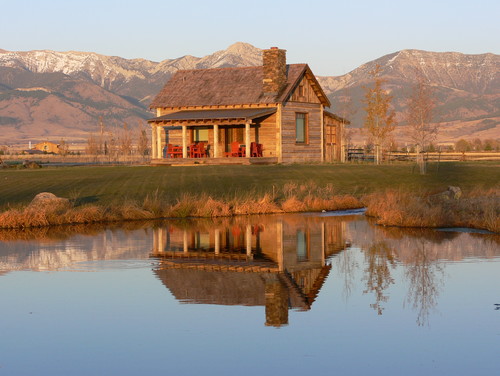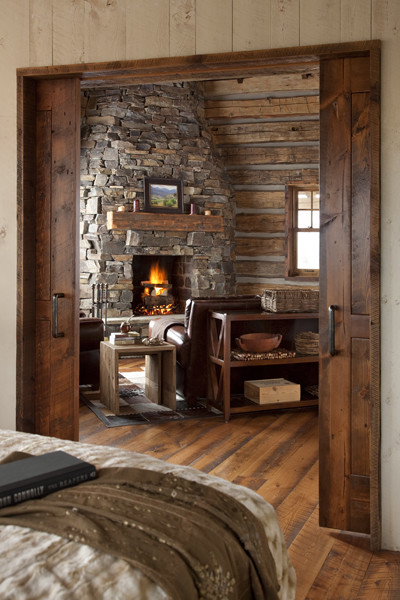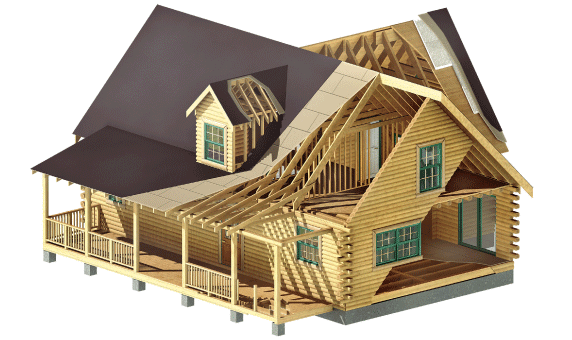Log homes are classic Americana–and the cabin by the lake in the woods is the “Montanan Dream”. Log homes can be as affordable or luxurious as you want. Big or small, hardwood floors or carpet, wood stoves or fireplaces, as many or few logs as you like–the choices are seemingly endless. Like most building, however, the choices can get overwhelming quickly, so here’s the (almost) complete guide to building a Montana log home without breaking the bank–from WBC.

The Building Process
1. Planning
Planning your new log home might take months depending on how complex your home is. If you want a custom plan or an extensive customization of a stock plan, hire an architect or use your log home company’s in-house designer if they have one. Make sure you hire one that you can really communicate your dreams to. “A picture’s worth a thousand words” so use a site like Houzz.com to get your visions across. Often, a good architect or builder can suggest ways to get the look you want at a better cost. Your architect should also be familiar with log home construction.

Once you’ve picked your architect, one of the first things you need to consider is the floor plan. Nothing makes your home fit you like a glove than a custom plan, but they’re expensive–architects aren’t cheap and planning can take many months whichever route you take. On the other side of the spectrum are the stock plans–most log home companies offer them. Stock plans can be used as-is, but more usually, it’s used as a starting point to customize. This is a popular route and probably the best compromise between the two.
At some point in the process, you’ll need to pick your log home company. Choose one that has a solid reputation, is willing to show you a previous home that they built, and that charges fair and square. Remember that the prices you see on the web for log homes are might be anything from just the raw logs to logs plus hardware to logs assembled on site, so be sure to ask.
The types of log homes can be overwhelming. You have handcrafted, drawknifed Swedish Cope or hand scribed log homes, flat on flat logs or milled logs in just about every conceivable size and shape. There’s even concrete logs, log siding and split logs with insulation in the middle. Whew! It’s a mostly a matter of taste, but as a rule of thumb the handcrafted scribed ones are more expensive but often better quality, while flat on flat and milled are less expensive but lack the charm–and sometimes the reliability–of handcrafted ones.

At some point during this stage, you will have bought your land and situated your home. Make sure it’s a good spot; solid rock is not the best thing to put a foundation and utilities through. Make sure the log delivery truck can get up there!
Careful planning now can save dollars–and hurt–later. Things like placing the home with its back to the hill and prevailing winds, deep eaves to keep the log walls (and deck) away from the sun, and sturdy metal roofs are all smart choices to keep your log home around at least as long as you.
Finally, choose a builder. Reputation, realistic outlook, can-do attitude, a “just the facts” mindset and the honesty to admit “I’m not familiar with that, but we can look into it” are all things to look for. Like your architect , your builder must be familiar with log homes.
All these can be separate, but many log home firms offer design/build services that run the gamut. Pick what’s best for you.
2. Prep
The next stage begins the actual construction. Many home owners start by putting in water, electric and septic systems, although some experts recommend to wait till last, arguing that you don’t need the systems until just before you move in, so why sink thousands of dollars into something you won’t use for months and might be damaged by heavy equipment? It’s up to you and your builder. In any case, you’ll need to put in a foundation, whether it be a basement, crawl space, or slab.
Meanwhile, your log home is under construction at the log home company, then is delivered to your site. You’re ready to go!
3. Building
Now your log home is put up and the real “fun” begins.
The tips below can save you big bucks in the long run:
- Hallways ares dead space that’s best used somewhere else
- Smaller square footage will save a good chunk
- A small spaces can be defined well with half or knee walls that will keep the view open, thus making the room seem comfortable than cramped
- Take advantage of connections; “It’s not what you know, it’s who you know.”
- Save on labor; labor is probably the biggest single expenditure. Get a good price, but don’t go cheap–usually, “You get what you pay for.”
- Less expensive materials; for example, premium hardwood flooring might be your dream floor, but less expensive wood flooring, linoleum or carpet can work just as well.

Rustic Bedroom by Scottsdale Architects & Building Designers Swaback Partners, PLLC - Do what you can yourself; most jobs are best left to the pros, but, depending on your skills, landscaping or other tasks can be the greatest do it yourself project you’ll ever undertake.
- Be careful of the attitude, “Oh, an extra thousand dollars here or a hundred dollars there won’t hurt.” Going over budget by five figures when you’re finished isn’t pleasant. Keep within budget and make sure everything is spelled out as carefully as possible before you start.
- Cut down on logs; using logs only for the exterior walls can save big time and allow for easier remodeling later.
A few unique things to consider when dealing with log homes include settling (logs usually settle farther than dimensional lumber, so if you have an interior wall made of 2×6’s or other dimensional lumber make sure there’s extra space above for settling), log sanding, staining (logs must be stained to protect them from the weather) and chinking (sealant for the cracks between the logs).
Remember that while log homes are unique in many ways, most of the home is built with conventional construction techniques. Take a look at the choices in roofing, cabinetry, flooring, wall coverings and more on our website.
4. Maintenance
Maintaining a log home is different from maintaining a conventional home, but the costs and time are actually fairly low if you plan well. A re-staining and re-chinking every few years might be all that you need. Check out our article on log home maintenance for more information.
Conclusion
Wondering where to start? If you’re after more education, visit loghome.com. If you’d like some hands-on advice, need a builder recommendation, or would like to start building, come by your local WBC. You can get whatever you need for building log homes (except for the logs themselves) right here at Western Building Center. Log screws, stain, tools, chinking, and all kinds of building materials are all right here.
Drop by your [button link=”https://westernbuildingcenter.com/stores/”]local store[/button] today!



